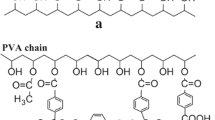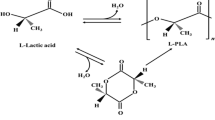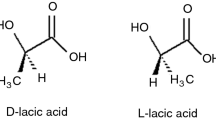Abstract
This study focuses on the synthesis and application of dibutyrate of bis(2-hydroxyethyl) terephthalamide (DB-BHETA) as a plasticizer in poly(vinyl chloride) (PVC) compounding. DB-BHETA was synthesized from poly(ethylene terephthalate) bottle waste through aminolysis followed by condensation reaction with butyric acid. Synthesized DB-BHETA was characterized by FTIR, DSC and NMR. Plasticized PVC was prepared by melt blending of PVC in different ratios with DB-BHETA and the mechanical, thermal and rheological properties were investigated. The glass transition temperature (T g) decreased with increasing concentration of DB-BHETA, confirming its plasticizing effect. The impact properties of PVC/DB-BHETA were maximum at weight ratio of 80/20. Shore hardness continuously reduced with increase in the concentration of DB-BHETA in PVC. Also, incorporation of DB-BHETA results in a gradual decrease in the loss modulus (viscous) and an increase in the storage modulus (elastic).





Similar content being viewed by others
References
Spychaj T, Fabrycy E, Spychaj S, Kacperski M (2001) Aminolysis and aminoglycolysis of waste poly(ethylene terephthalate). J Mater Cycles Waste Manage 3:24–31
Goje AS, Thakur SA, Patil TM, Mishra S (2003) Glycolytic aminolysis of poly(ethylene terephthalate) waste for recovery of value-added co-monomer at atmospheric pressure. J Appl Polym Sci 90:3437–3444
Soni RK, Singh S (2005) Synthesis and characterization of terephthalamides from poly(ethylene terephthalate) waste. J Appl Polym Sci 96:1515–1528
Goje AS, Thakur SA, Diware VR, Chauhan YP, Mishra S (2004) Aminolysis of poly(ethylene terephthalate) waste for recovery of value added comonomeric product. Polym Plast Technol Eng 43:407–426
Fabrycy E, Leistner A, Spychaj T (2000) New epoxy resin hardeners from PET scrap. Adhesion 44:35–39
Shukla SR, Harad AM (2006) Aminolysis of polyethylene terephthalate waste. Polym Degrad Stab 91:1850–1854
Pingale ND, Shukla SR (2009) Microwave-assisted aminolytic depolymerization of PET waste. Eur Polym J 45:2695–2700
Parab YS, Pingale ND, Shukla SR (2012) Aminolytic depolymerization of poly(ethylene terephthalate) bottle waste by conventional and microwave irradiation heating. J Appl Polym Sci 125:1103–1107
Shah RV, Shukla SR (2012) Effective aminolytic depolymerization of poly(ethylene terephthalate) waste and synthesis of bis-oxazoline therefrom. J Appl Polym Sci 125:3666–3675
Owen Jr (1978) Terephthalate ester polyols. US Patent 4100354
Ralph TK Cornwell, Rosemont, Pa. (1958) Film-forming composition with a terephthalamide ester plasticizer and an article coated therewith. US patent 2,824,016
Ralph TK Cornwell, Rosemont, Pa. (1958) US patent 2,824,017
Ralph TK Cornwell, Rosemont, Pa. (1958) US patent 2,824,018
Titow WV (1984) PVC Technology, 4th edn. Elsevier Applied Science, New York
Saad ALG, Hussien LI, Ahmed MGM, Hassan AM (1998) Studies of electrical and mechanical properties of semiconductive poly(vinyl chloride) compositions. J Appl Polym Sci 69:685–693
Watkinson K, Mohsen R (1982) Effect of concentration and type of plasticizer on some physical properties of poly(vinyl chloride). J Appl Polym Sci 27:3455–3460
Rahman M, Brazel CS (2004) The plasticizer market: an assessment of traditional plasticizers and research trends to meet new challenges. Prog Polym Sci 29:1223–1248
Toja F, Saviello D, Nevin A, Comelli D, Lazzari M, Levi M, Toniolo L (2012) The degradation of poly(vinyl acetate) as a material for design objects: a multi-analytical study of the effect of dibutyl phthalate plasticizer. Polym Degrad Stab 97:2441–2448
Rehm T (1997) The compression set of plasticized PVC. J Vinyl Addit Technol 3:286–291
Ramos-Devalle L, Gonzalez-Roa C, Sanchez-Adame M, Rodriguez JZ (1992) Compatibility between PVC and plasticizer blends and its relation with processing. J Vinyl Technol 14:74–77
Xu X, Guo S (1995) Plasticizing effect of low molecular weight PVC prepared by vibromilling degradation on PVC. Polym Plast Technol Eng 34:679–688
Soong SY, Cohen RE, Boyce MC (2007) Polyhedral oligomeric silsesquioxane as a novel plasticizer for poly(vinyl chloride). Polymer 48:1410–1418
Shah BL, Shertukde VV (2003) Effect of plasticizers on mechanical, electrical, permanence, and thermal properties of poly(vinyl chloride). J Appl Polym Sci 90:3278–3284
Greco A, Brunetti D, Renna G, Mele G, Maffezzoli A (2010) Plasticizer for poly(vinyl chloride) from cardanol as a renewable resource material. Polym Degrad Stab 95:2169–2174
Bailey AV, Boudreux GJ, Sumrell G (1978) Preparation of some mono- and diester of N, N disubstituted amide and their evaluation as plasticizer. J Am Chem Soc 55:459–462
Liang GG, Cook WD, Sautereau HJ, Tcharkhtchi A (2009) Diallyl orthophthalate as a reactive plasticizer for improving PVC processibility, Part II: rheology during cure. Polymer 50:2635–2642
Acknowledgments
The authors gratefully acknowledge the financial support provided by The University Grant Commission (UGC) under the CAS-SAP scheme for the study.
Author information
Authors and Affiliations
Corresponding author
Rights and permissions
About this article
Cite this article
Parab, Y.S., Wasekar, P.A., Mhaske, S.T. et al. Novel synthesis, characterization and application of dibutyrate bis(2-hydroxyethyl) terephthalamide as a plasticizer in PVC compounding. Polym. Bull. 71, 2695–2707 (2014). https://doi.org/10.1007/s00289-014-1218-y
Received:
Revised:
Accepted:
Published:
Issue Date:
DOI: https://doi.org/10.1007/s00289-014-1218-y




